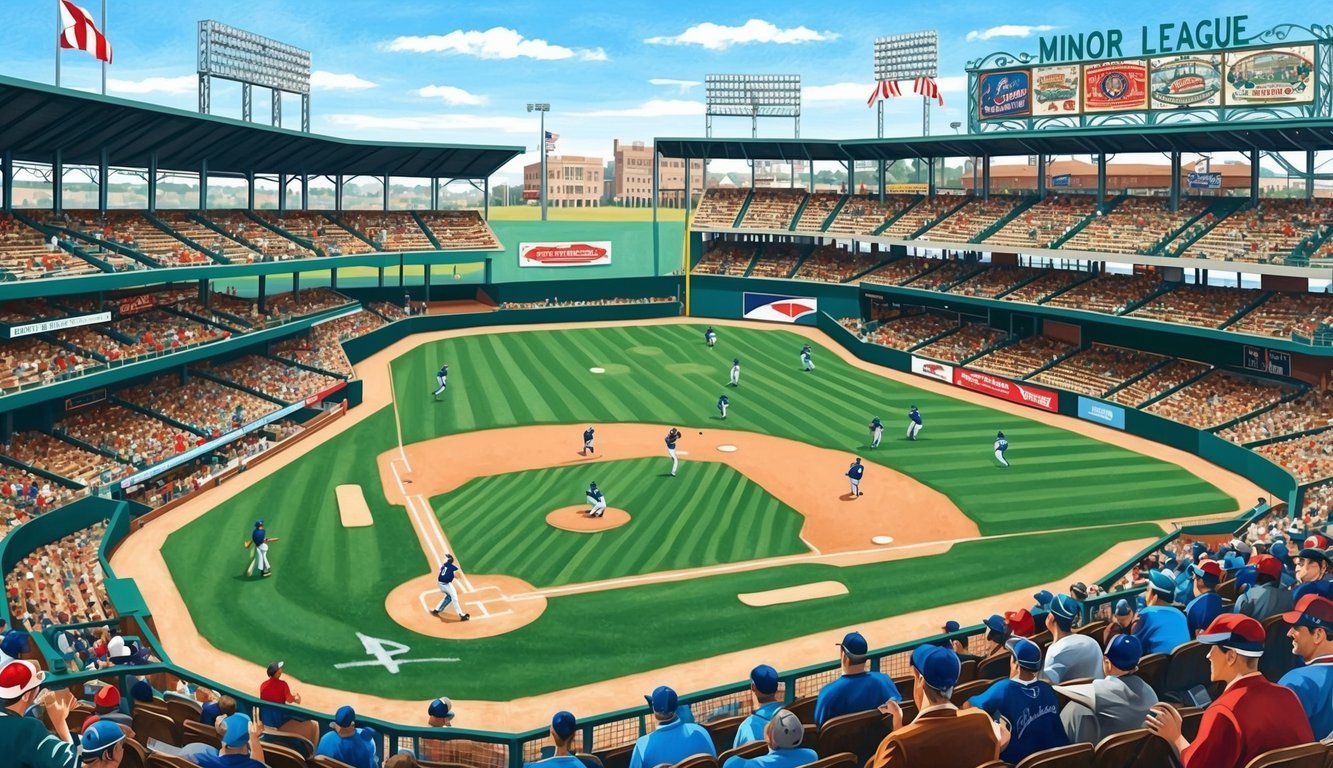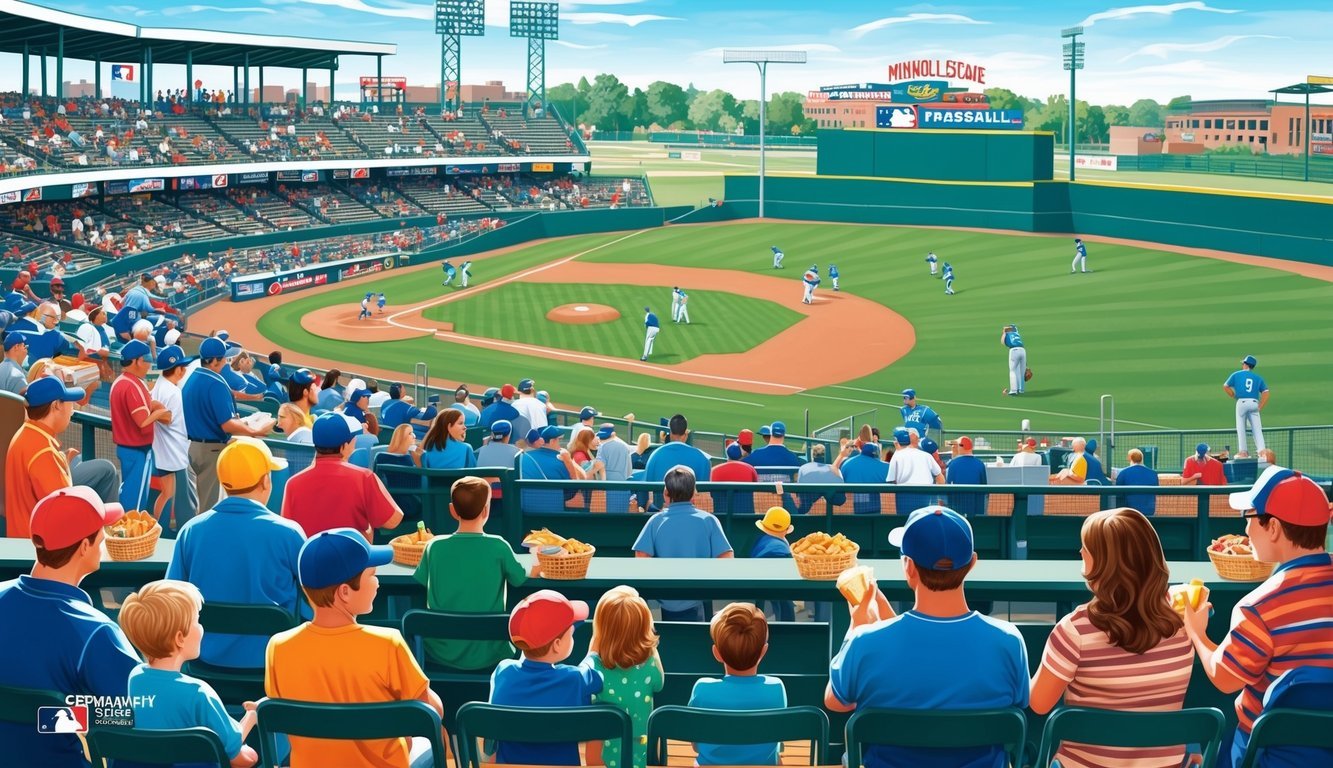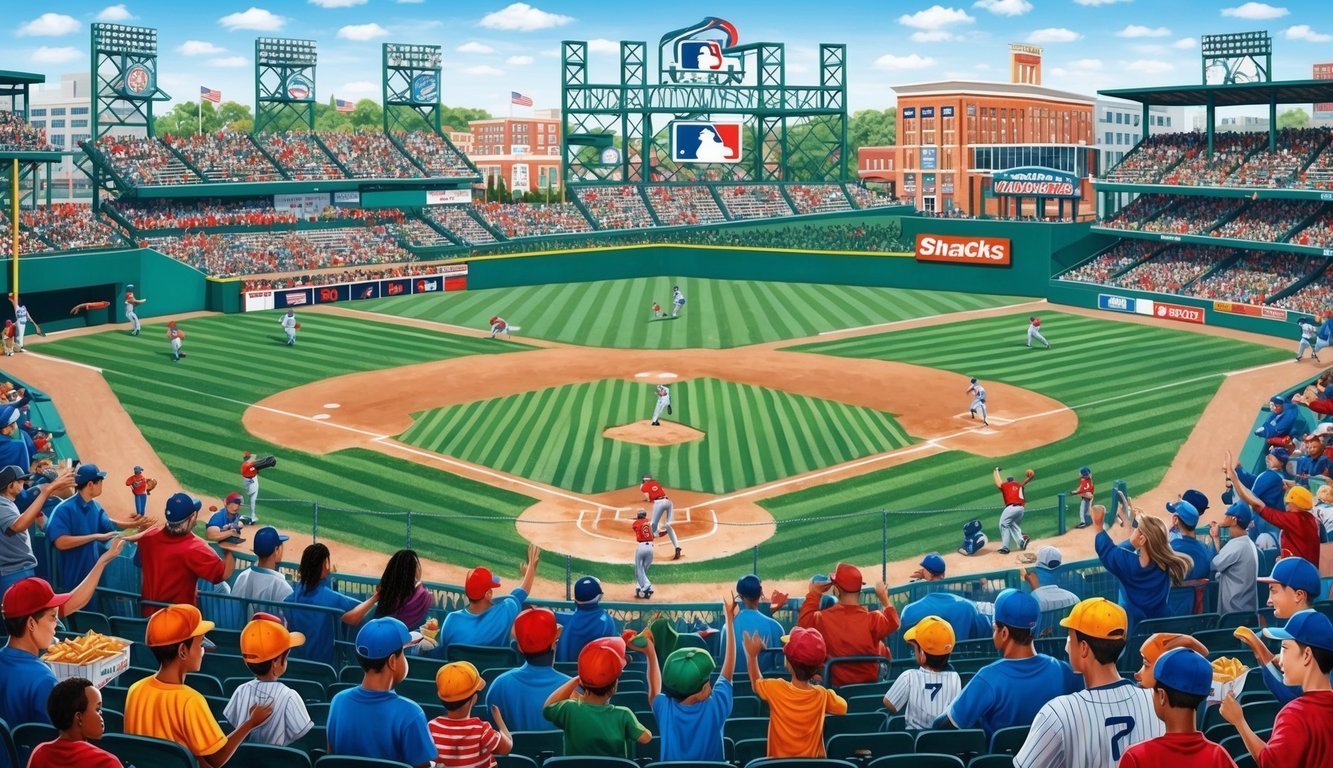Minor League Baseball serves as the lifeblood of America’s pastime, nurturing talent and connecting communities across the United States.
Over 100 affiliated teams provide stepping stones for aspiring players on their journey to the majors. These farm systems are crucial for developing and evaluating talent.
They give players the opportunity to hone their skills in a competitive environment before potentially reaching the big leagues.
The minor leagues offer fans an intimate baseball experience, with affordable tickets and family-friendly atmospheres.
Quirky team names, creative promotions, and up-close access to future stars make these games uniquely entertaining.
Beyond player development, minor league clubs play vital roles in their local economies, bringing jobs, tourism, and community pride to cities and towns across America.
History and Evolution of Minor League Baseball

Minor League Baseball’s rich history spans over a century, marked by significant growth and adaptation through challenging times.
The system has played a crucial role in developing talent and expanding the sport’s reach across North America.
Origins and Early Years
The roots of Minor League Baseball trace back to the 1880s.
In 1883, the Northwestern League emerged as one of the first organized minor leagues.
Soon after, the Eastern League formed in 1884.
These early leagues operated independently from major league teams but served as a proving ground for talented players.
The National Association of Professional Baseball Leagues, now known as Minor League Baseball, was established on September 5, 1901.
This organization brought structure and consistency to the minor league system, setting standards for player contracts and league operations.
By the early 1900s, a tiered system began to take shape.
Class A, B, C, and D leagues were created, with Class D being the lowest level of professional baseball.
Impact of World Wars and the Great Depression
World War I and the Great Depression posed significant challenges to Minor League Baseball.
Many teams struggled financially, and some leagues were forced to suspend operations.
The number of minor league teams dropped from 246 in 1941 to just 66 in 1943 due to World War II.
Despite these setbacks, Minor League Baseball showed remarkable resilience.
Branch Rickey, then with the St. Louis Cardinals, pioneered the “farm system” concept in the 1920s.
This innovative approach allowed major league teams to develop talent internally, strengthening the connection between major and minor leagues.
The post-war years saw a resurgence in Minor League Baseball.
By 1949, the number of teams had rebounded to 448, demonstrating the enduring appeal of the sport.
Resilience and Expansion Over Time
Minor League Baseball continued to evolve in the latter half of the 20th century.
The 1960s and 1970s saw a period of contraction, with many small-town teams folding due to financial pressures and changing demographics.
However, the 1980s and 1990s brought renewed growth.
New stadiums were built, often with public funding, attracting fans with improved facilities and family-friendly entertainment.
The minor league system also became more streamlined.
The current structure, featuring Triple-A, Double-A, High-A, and Low-A levels, was established to create a clearer path for player development.
In recent years, Minor League Baseball has faced new challenges, including a significant restructuring in 2021 that reduced the number of affiliated teams.
Despite these changes, it continues to play a vital role in developing talent and bringing baseball to communities across North America.
Structure of Minor League Baseball
Minor League Baseball forms a comprehensive developmental system for nurturing talent and preparing players for the big leagues.
It consists of multiple tiers and various team affiliations.
Classification Systems and Levels
Minor League Baseball is organized into several classifications.
Triple-A sits at the top, followed by Double-A and Single-A. Each level represents a step in player development.
Triple-A teams often host more experienced players who are nearly ready for the majors.
Double-A showcases rising stars and promising prospects.
Single-A is split into High-A and Low-A, focusing on younger talent still honing their skills.
A Rookie level also exists, typically for newly drafted players or international signings.
These leagues help players adjust to professional baseball in a more controlled environment.
Farm System and Team Affiliations
Every Major League Baseball team maintains a farm system of affiliated minor league clubs.
These affiliations allow MLB organizations to develop players at various levels.
Most MLB teams have one affiliate at each classification level.
This structure enables clubs to move players up or down based on performance and development needs.
Farm systems help big league teams cultivate talent internally.
They provide a pipeline of players ready to step in when injuries occur or upgrades are needed at the major league level.
Affiliations can change periodically, with MLB teams sometimes switching their partnerships to different minor league clubs.
The Role of Independent Leagues
Independent leagues operate outside the official Minor League Baseball structure.
They’re not affiliated with MLB teams but still play a role in the baseball ecosystem.
These leagues give opportunities to players who go undrafted or are released from affiliated ball.
Some independent league standouts eventually sign with MLB organizations.
Independent teams often focus on entertainment value, sometimes employing former major leaguers to boost fan interest.
They provide baseball to communities that might not have affiliated teams nearby.
While not part of the formal minor league system, independent leagues contribute to baseball’s overall talent pool and help keep the sport thriving in various markets.
Player Development and Opportunities
Minor league baseball serves as a crucial stepping stone for aspiring players.
It provides a platform for growth, skill refinement, and the chance to catch the eye of major league scouts.
From Rookie to Major League Prospect
Rookies enter the minor league system with dreams of reaching the big leagues.
They start in lower levels like Rookie or Class A, facing fierce competition.
Players hone their skills through daily practice and games.
Farm teams offer a structured environment for young talents to mature.
Coaches work closely with prospects, helping them adjust to professional baseball’s demands.
As players improve, they may advance to higher levels like Double-A or Triple-A.
The journey from rookie to major league prospect is often long and challenging.
It requires dedication, hard work, and continuous improvement.
Only a small percentage of minor leaguers make it to the MLB, but the experience is invaluable for all.
Scouting, Training, and Coaching
Scouts play a vital role in identifying promising talents for MLB organizations.
They attend high school and college games, evaluating players’ skills and potential.
Once signed, prospects receive specialized training.
Coaches focus on:
- Hitting mechanics
- Pitching techniques
- Fielding skills
- Base running
- Mental preparation
Modern technology aids player development.
Video analysis and data analytics help pinpoint areas for improvement.
Strength and conditioning programs enhance physical performance.
Coaches mentor young players, teaching them the nuances of the game.
They also help prospects adapt to the lifestyle of professional baseball, including travel and media interactions.
The Draft and Career Advancement
The MLB Draft is a pivotal moment for aspiring players.
Top prospects may be selected out of high school or college.
Newly drafted players typically start in the lower minor leagues.
Career advancement depends on performance and potential.
Standout players may quickly move up the ranks.
Others might spend years developing their skills at various levels.
Key factors in advancement:
- Consistent performance
- Skill improvement
- Adaptability
- Mental toughness
Teams closely monitor their prospects’ progress.
Players who excel may earn promotions or even a coveted spot on the major league roster.
The minor leagues offer a path for young talents to chase their big league dreams.
Economic and Community Impact

Minor league baseball teams play a significant role in local economies and community life.
They create jobs, boost local businesses, and provide affordable entertainment for families.
Local Economy and Job Creation
Minor league baseball teams generate revenue and employment opportunities in their host cities.
Stadiums require staff for operations, concessions, and maintenance.
Local businesses like restaurants and hotels benefit from increased foot traffic on game days.
Teams create seasonal jobs for players, coaches, and support staff.
Vendors and suppliers also see increased demand for their products and services.
The economic ripple effect extends beyond the ballpark, stimulating growth in surrounding areas.
Some studies suggest that AAA or A+ minor league teams can increase per-capita income in their cities by $67 annually.
However, the exact impact varies depending on team level and local economic conditions.
Community Engagement and Fan Base
Minor league baseball fosters a strong sense of community identity and pride.
Teams often become cherished local institutions, bringing residents together for shared experiences.
Family-friendly promotions and affordable ticket prices make games accessible to a wide audience.
Mascots, between-inning contests, and theme nights create a fun atmosphere that appeals to all ages.
Teams frequently participate in community outreach programs, visiting schools, hospitals, and local events.
Players often become local celebrities, interacting with fans and contributing to charitable causes.
This engagement helps build a loyal fan base that supports the team through ups and downs.
The hometown connection creates a unique, intimate experience distinct from major league games.
Challenges and Adaptations
The COVID-19 pandemic posed significant challenges for minor league baseball.
Cancelled seasons and reduced attendance impacted revenue streams and community involvement.
Teams adapted by implementing safety measures, offering alternative events, and leveraging digital platforms to maintain fan connections.
Some explored creative uses for their facilities during downtime.
Long-term challenges include balancing player development with community engagement and managing operational costs.
Teams must continually innovate their marketing strategies and enhance the fan experience to compete with other entertainment options.
Despite these hurdles, minor league baseball’s symbiotic relationship with local communities remains strong.
Teams continue to adapt, finding new ways to provide value and maintain their role as important civic institutions.
The Cultural and Entertainment Value

Minor League Baseball offers much more than just a stepping stone to the majors.
It provides a unique blend of sport, entertainment, and community connection that resonates deeply with fans across America.
Minor League Baseball as American Pastime
Minor League Baseball has cemented its place as a beloved American pastime.
Local teams become the heart of their communities, fostering a sense of pride and belonging.
Families and friends gather at ballparks to enjoy affordable entertainment and create lasting memories.
As the season progresses, the excitement builds, culminating in the thrilling postseason where the stakes are higher than ever.
Fans eagerly anticipate the chance to see their teams compete under the baseball playoff format explained, with its unique structure that adds an extra layer of intensity to each game.
This shared experience not only strengthens community bonds but also keeps the spirit of baseball alive through generations.
The intimate atmosphere of minor league stadiums allows fans to feel closer to the action.
Many parks feature family-friendly areas, playgrounds, and picnic spots, making game days a full experience beyond just watching baseball.
These teams often celebrate local culture through team names, mascots, and special events.
This connection to community spirit strengthens the cultural significance of minor league clubs in their hometowns.
Promotions and Fan Engagement
Minor League Baseball is renowned for its creative and often quirky promotions.
Teams constantly innovate to attract and entertain fans.
Theme nights, giveaways, and special events are common, ranging from popular movie tributes to unusual concepts like “Awful Night” or “Salute to Bacon.”
Interactive experiences are a staple of the minor league game day.
Fans may participate in on-field contests between innings or meet players for autographs after games.
Many teams also organize youth clinics and community outreach programs, further strengthening their local ties.
Social media engagement has become crucial for teams to connect with fans.
Clubs use platforms like Twitter and Instagram to share behind-the-scenes content, run contests, and keep fans updated on team news and events.
Media Coverage and Technological Advancements
While Major League Baseball gets more national attention, minor league coverage has also expanded significantly.
Local broadcasters often become beloved figures in their communities.
They provide play-by-play and stories that connect fans to their teams.
Streaming services have made it easier for fans to follow their favorite minor league teams from anywhere.
Many leagues now offer subscription packages that allow viewers to watch games online.
This expands the reach of these smaller markets.
Technological advancements have also improved the in-stadium experience.
Modern scoreboards, advanced stats displays, and app-based ordering systems for concessions enhance fan engagement during games.
Some teams have embraced virtual reality and augmented reality experiences.
They offer fans new ways to interact with the game and players.
These innovations keep Minor League Baseball relevant in an increasingly digital entertainment landscape.
